America, the Great Colossal Collage: Saul Steinberg’s Forgotten Masterpiece
The spectacular, panoramic, pasted-paper mural that Saul Steinberg created for the American Pavilion of the 1958 Brussels World’s Fair is reassembled for the first time at the Ludwig Museum
In 1957 Saul Steinberg, the Romanian-born artist and illustrator who emigrated to the United States during World War II, was asked to make a mural that would explain his adopted country to an expected audience of 40 million people.
The venue was the American Pavilion of the 1958 Expo in Brussels, the first world’s fair since 1937 and the first to be staged during a new kind of war, the Cold one.
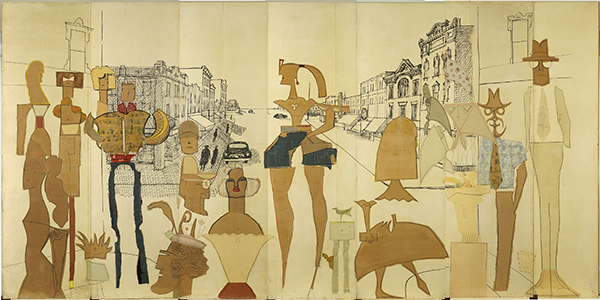
- Saul Steinberg, The Americans. Main Street – Small Town, 1958, collage of wrapping paper, wallpaper, cut out or wrapped out illustrated newspaper-pages, adhesive tape, wax crayon, pastel, oil on printed photo-paper, glued on cardboard and attached on double-thick Triplex-plate. MUSÉES ROYAUX DES BEAUX-ARTS DE BELGIQUE, BRUXELLES, © THE SAUL STEINBERG FOUNDATION / VG BILD-KUNST 2013.
Steinberg, who had forged his mutual careers by then as a fine artist and commercial artist admired for his drawings in the New Yorker, Vogue, and other magazines, was also known for the edgy murals he created in settings ranging from the cruise ships of the American Export Lines to the Bonwit Teller department store.
For Brussels, his assignment was to create a “montage of the paraphernalia employed by Americans in every-day life.” That was the concept of the team organizing the pavilion, architects Peter G. Harnden and Bernard Rudofsky, along with art historian James S. Plaut. They wanted something “not only amusing, but also informative, ironic, and attractive.”
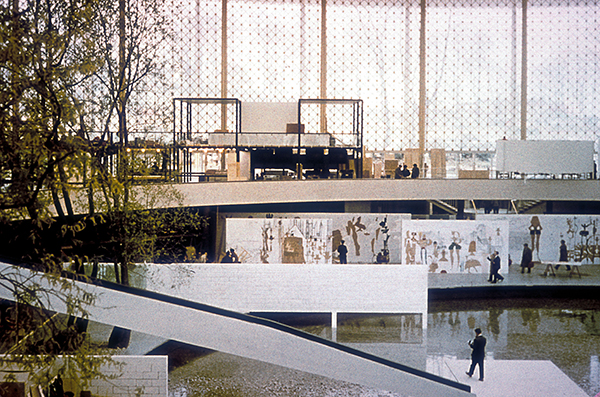
A view of Steinberg’s murals installed in Edward Durell Stone’s structure for the American Pavilion at Expo 1958, Brussels, unknown photographer. PRIVATE ARCHIVE.
The Americans was conceived for the foyer of the huge circular structure designed by Edward Durell Stone (which also housed a patriotic Disney Circarama and replicas of classic Americana like voting booths, hot dog carts, and soda fountains).
Steinberg liked the organizers’ suggestion to use enlarged black-and-white drawings as a surface, so before the fair, he sent some of his drawings to be enlarged photographically. In Brussels, the prints were affixed to freestanding walls. This was his “décor,” where his bizarre cast of characters would reside. He envisioned the settings as akin to dioramas in natural-history museums.
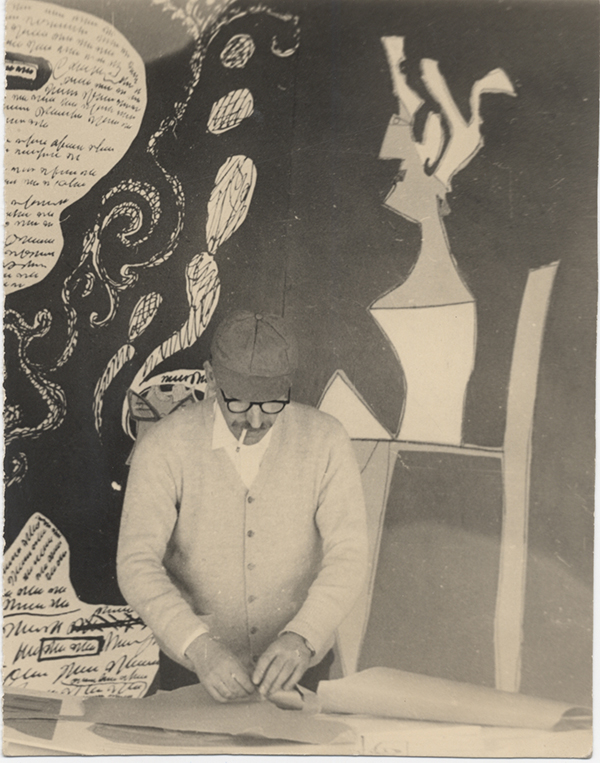
Saul Steinberg during the set-up of the exhibition at the American Pavilion of Expo 58, Brussels 1958. ©THE SAUL STEINBERG FOUNDATION / VG BILD-KUNST 2013/ KMSKB-MRBAB.
Once he was on site, he began the process of montage. He added to the walls brown-paper cutouts, wallpaper fragments, handmade paper, newspaper comics, and other pieces in various shapes and hues, creating a stunning, inventive panorama of America, from small-town Main Street to big-city cocktail party.
Brimming with visual puns, semi-abstractions, distorted figures, and modernist white space, The Americans represented Steinberg’s effort at cultural diplomacy.
“We are not going to Brussels to boast,” he told a journalist. “We want to show how we really are. There are few people who can afford to grin a little bit at themselves. We can.”
His nuanced sensibility didn’t mesh with the populist idea of great American art at that moment, and the mural didn’t make much of a splash. Some reviewers took potshots at The Americans; most ignored it completely. Stone’s pavilion, deemed an architectural triumph, made the cover of Time. Steinberg’s art was left out of the Official United States Guidebook.
After efforts to place the mural in an American museum after the fair fizzled, the Musées royaux des Beaux-Arts de Belgique agreed to acquire it so it wouldn’t be destroyed. Since the 1990s, two scenes, Drugstore and Cocktail Party, have hung in the museum’s restaurant. The rest have rarely been shown.
This month the Ludwig Museum in Cologne will reassemble the mural to show The Americans in its complete state for the first time since 1958. The exhibition, also called “The Americans,” includes the original eight panels (which had been cut after the fair into 84 parts to facilitate transport) along with 73 of the artist’s contemporaneous drawings, collages, and paper-bag masks. Opening March 23, “The Americans” marks the revival of a nearly forgotten masterpiece.
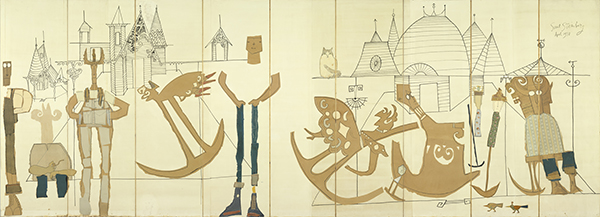
Saul Steinberg, The Americans. Farmers – Middle West, 1958, collage of cut out or wrapped out wrapping paper and wallpaper, wax crayon, pastel, India ink, oil on printed photo-paper, glued on cardboard and attached on double-thick Triplex-plate. MUSÉES ROYAUX DES BEAUX-ARTS DE BELGIQUE, BRUXELLES, ©THE SAUL STEINBERG FOUNDATION / VG BILD-KUNST 2013.
In a biographical essay in the catalogue, Iain Topliss traces the artist’s lifelong love of collage to his childhood spent in his father’s bookbinding workshop in Bucharest, surrounded by alluring bits of colored paper. As anti-Semitism rose in Romania, Steinberg left for Milan, where he studied architecture and began his artistic career. He escaped Fascist Italy in 1941 and (after a year in Santo Domingo) arrived in the United States in late June 1942. He became a naturalized American citizen by 1943.
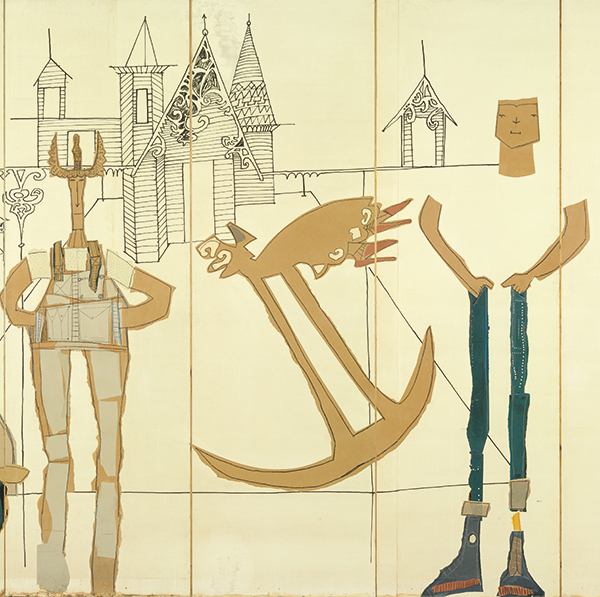
Saul Steinberg, The Americans. Farmers – Middle West, detail, 1958, collage of cut out or wrapped out wrapping paper and wallpaper, wax crayon, pastel, India ink, oil on printed photo-paper, glued on cardboard and attached on double-thick Triplex-plate. MUSÉES ROYAUX DES BEAUX-ARTS DE BELGIQUE, BRUXELLES, ©THE SAUL STEINBERG FOUNDATION / VG BILD-KUNST 2013.
The challenge of depicting the diversity of the United States preoccupied Steinberg. In January 1958 he wrote to his friend Aldo Buzzi: “I’m in trouble, I have to do a one-hundred-meter mural for the show in Brussels, I must use my cabeza, think (the subject is people in U.S. How do you draw the blacks?)”. Though he had used brown paper to represent people of color in other works, such as Couple (1955), in Brussels Steinberg decided to use the paper to signify skin of all colors.
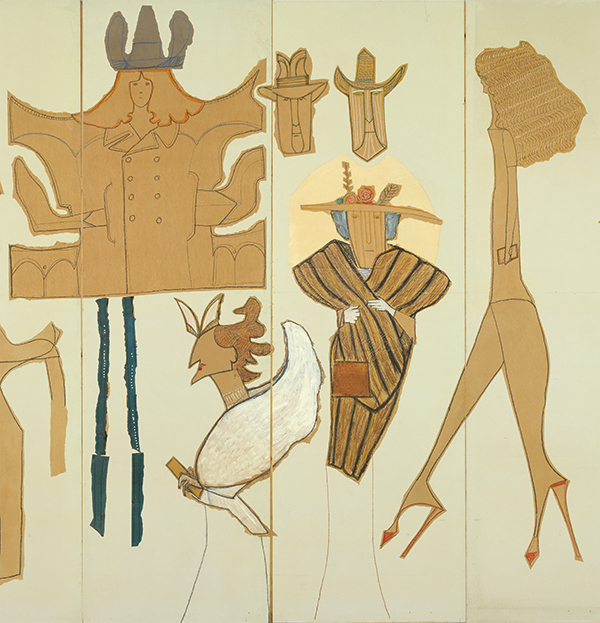
Saul Steinberg, The Americans. California, Florida and Texas, detail, 1958, collage of cut out or wrapped out wrapping paper, metal clips, wax crayon, pastel, oil on double-thick painted Triplex-plate. MUSÉES ROYAUX DES BEAUX-ARTS DE BELGIQUE, BRUXELLES, © THE SAUL STEINBERG FOUNDATION / VG BILD-KUNST 2013.
In a thoughtful catalogue essay, Melissa Renn situates the mural in a multi-media, multinational dialogue: with Picasso’s pasted papers; with Pollock’s cutouts; and with the collages of European Pop artists like Richard Hamilton, Peter Blake, and Eduardo Paolozzi. As Renn notes, The Americans appeared right before The Street, the immersive panorama of cardboard, burlap, and newspaper that Claes Oldenberg made in 1960.
Steinberg’s The Americans also shares a sensibility with another The Americans, the influential photo series by another well-traveled European immigrant, Robert Frank. Renn detects the immigrant’s detachment in Steinberg’s formal tricks in the panels–the way the colorful figures float on the back-and-white background without becoming part of them. They make assimilation look hard.
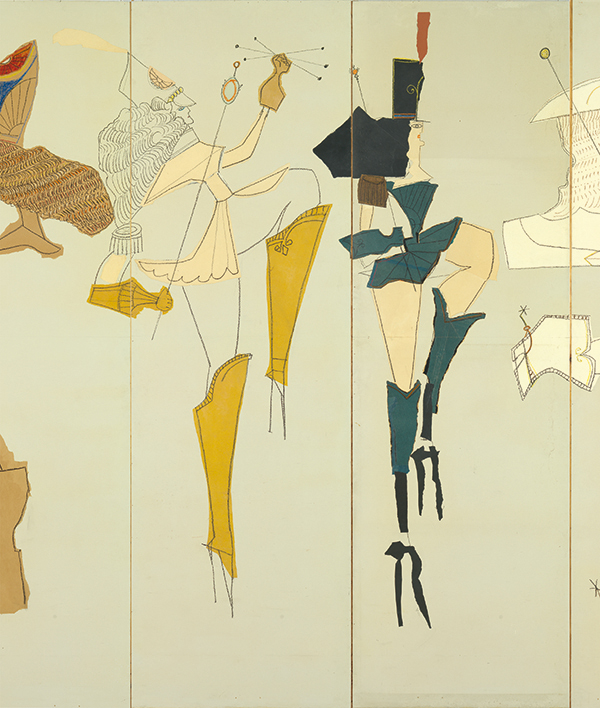
Saul Steinberg, The Americans. California, Florida and Texas, detail, 1958, collage of cut out or wrapped out wrapping paper, metal clips, wax crayon, pastel, oil on double-thick painted Triplex-plate. MUSÉES ROYAUX DES BEAUX-ARTS DE BELGIQUE, BRUXELLES, © THE SAUL STEINBERG FOUNDATION / VG BILD-KUNST 2013.
“Steinberg had been a parade addict for years,” LIFE reported in 1951, “admits he knows them all ‘by heart,’ but inevitably finds himself holding down a curbside position when the flags go by. ‘It gives me an excuse to be staring at people.’ ”
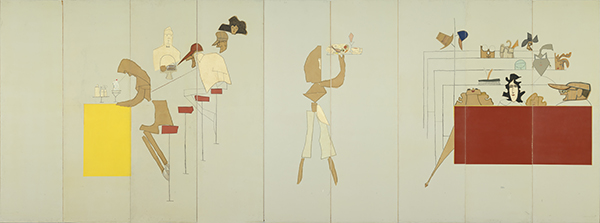
Saul Steinberg, The Americans. Drugstore – Small Town, 1958, collage of cut out or wrapped out wrapping paper and wallpaper, wax crayon, pastel, oil on double-thick painted Triplex-plate. MUSÉES ROYAUX DES BEAUX-ARTS DE BELGIQUE, BRUXELLES, ©THE SAUL STEINBERG FOUNDATION / VG BILD-KUNST 2013.
Steinberg loved luncheonettes. “The diner is one of the most elegant, most pleasant, most American places,” he believed. “…There’s always a lovely view outside: a parking lot, a road full of traffic, or some backyard with unexpected sights; or else a motel.”
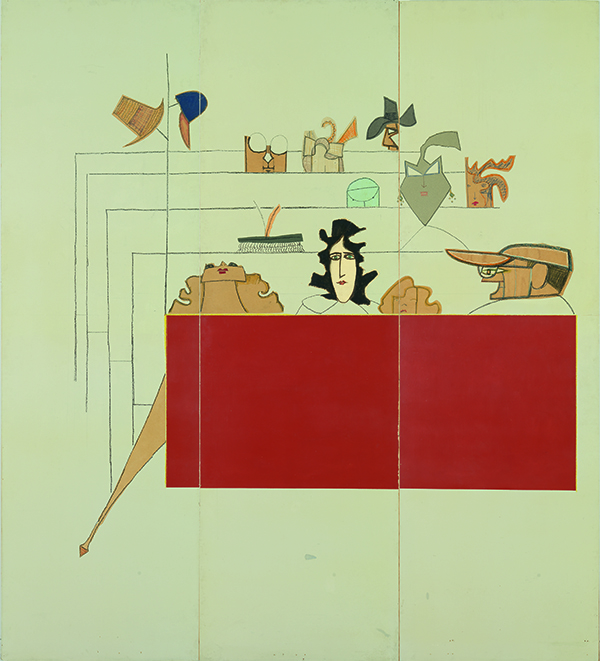
Saul Steinberg, The Americans. Drugstore – Small Town, detail, 1958, collage of cut out or wrapped out wrapping paper and wallpaper, wax crayon, pastel, oil on double-thick painted Triplex-plate. MUSÉES ROYAUX DES BEAUX-ARTS DE BELGIQUE, BRUXELLES, © THE SAUL STEINBERG FOUNDATION / VG BILD-KUNST 2013.
Drugstore detail. The cut-out faces are the forebears of Steinberg’s paper-bag masks, which he began making the next year and will be included in the show. The figure in the baseball cap at the right may be a self-portrait.
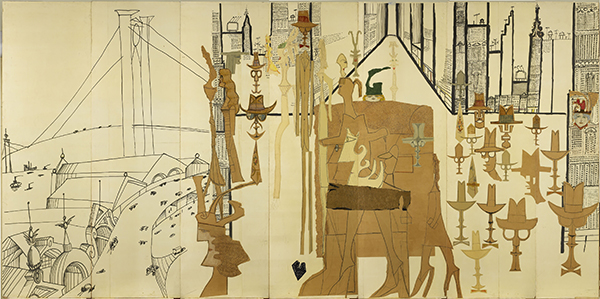
Saul Steinberg, The Americans. Downtown – Big City, 1958, collage of cut out or wrapped out wrapping paper, wax crayon, pastel, India ink, on printed photo-paper, glued on cardboard and attached on double-thick Triplex-plate. MUSÉES ROYAUX DES BEAUX-ARTS DE BELGIQUE, BRUXELLES, ©THE SAUL STEINBERG FOUNDATION / VG BILD-KUNST 2013.
The big city, with its suspension bridge, skyscraper, weird square women, and men defined by their hats and ties.
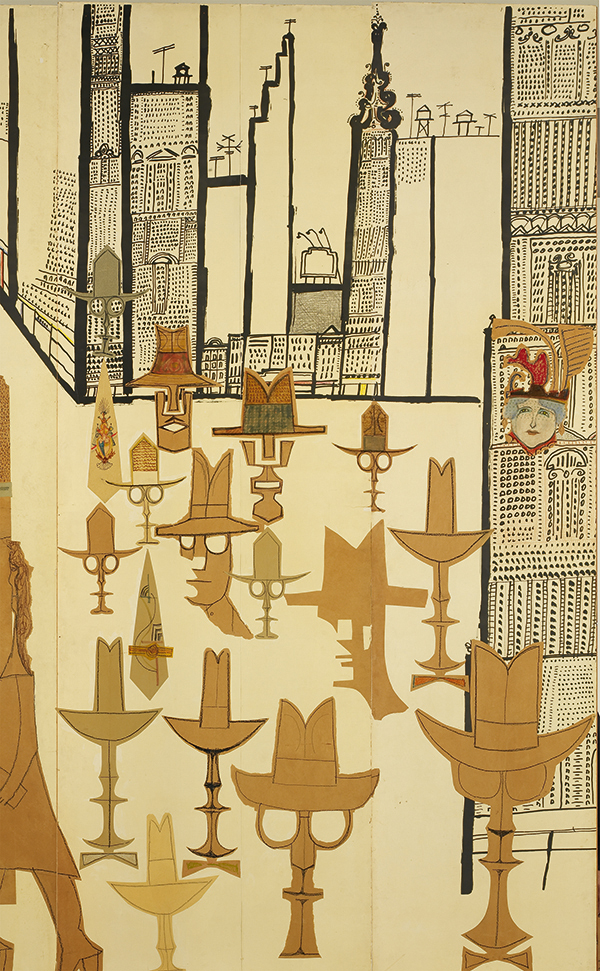
Saul Steinberg, The Americans. Downtown – Big City, detail, 1958, collage of cut out or wrapped out wrapping paper, wax crayon, pastel, India ink, on printed photo-paper, glued on cardboard and attached on double-thick Triplex-plate. MUSÉES ROYAUX DES BEAUX-ARTS DE BELGIQUE, BRUXELLES, ©THE SAUL STEINBERG FOUNDATION / VG BILD-KUNST 2013.
A detail of the big-city scene. A commentary on corporate conformity?
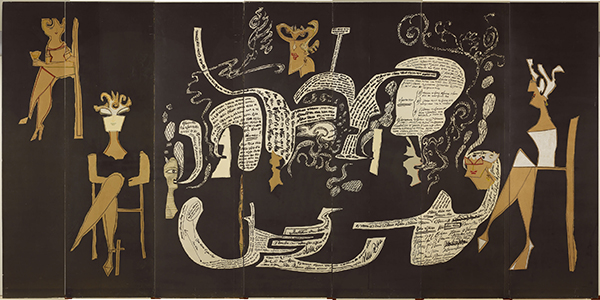
Saul Steinberg, The Americans. Cocktail Party, 1958, collage of cut out or wrapped out wrapping paper, wax crayon, pastel, India ink, oil on printed photo-paper, glued on cardboard and attached on double-thick Triplex-plate. MUSÉES ROYAUX DES BEAUX-ARTS DE BELGIQUE, BRUXELLES, ©THE SAUL STEINBERG FOUNDATION / VG BILD-KUNST 2013.
The urbane crowd at a big-city cocktail party chatters in Steinberg’s false writing, which may be a sideways riff on Pollock.
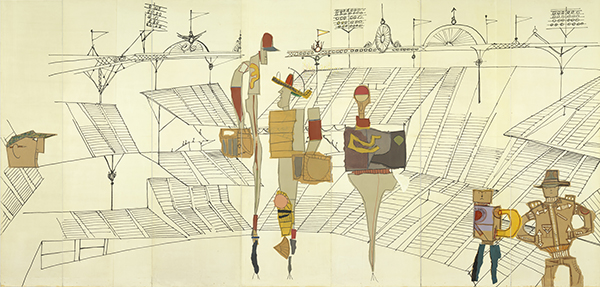
Saul Steinberg, The Americans. Baseball, 1958, collage of cut out or wrapped out wrapping paper, wax crayon, pastel, India ink on printed photo-paper, glued on cardboard and attached on double-thick Triplex-plate. MUSÉES ROYAUX DES BEAUX-ARTS DE BELGIQUE, BRUXELLES, ©THE SAUL STEINBERG FOUNDATION / VG BILD-KUNST 2013.
Baseball players became recurring characters in Steinberg’s work after 1954, when LIFE sent him on the road with a team.
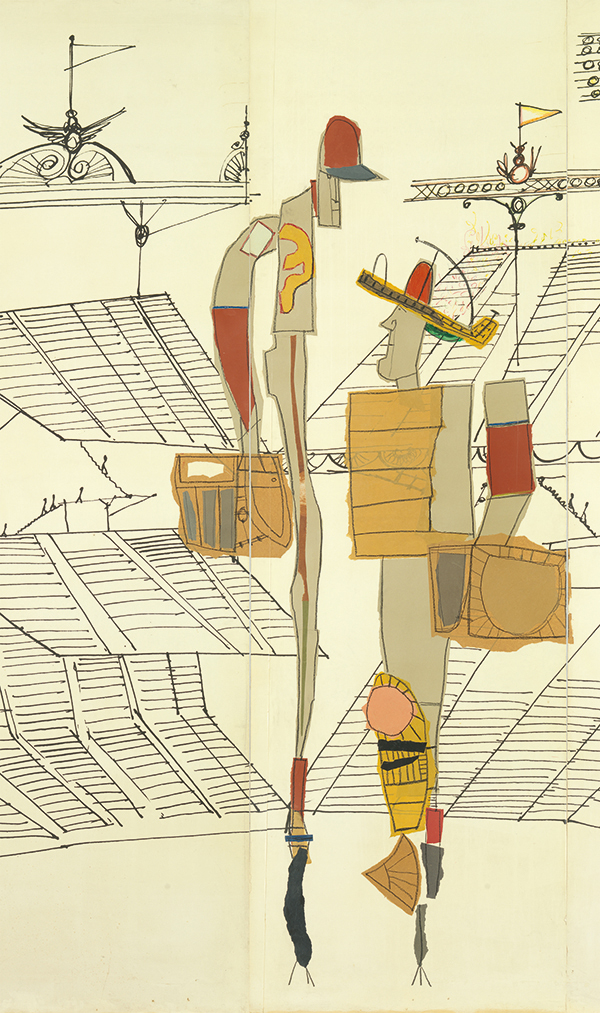
Saul Steinberg, The Americans. Baseball, detail, 1958, collage of cut out or wrapped out wrapping paper, wax crayon, pastel, India ink on printed photo-paper, glued on cardboard and attached on double-thick Triplex-plate. MUSÉES ROYAUX DES BEAUX-ARTS DE BELGIQUE, BRUXELLES, ©THE SAUL STEINBERG FOUNDATION / VG BILD-KUNST 2013.
In a sense, the baseball scene provides a key to understanding the rest of the panels: “Baseball is an allegorical play about America, a poetic, complex and subtle play of courage, fear, good luck, mistakes, patience about fate and sober self-esteem,” Steinberg is famously quoted as commenting. “It is impossible to understand America without a thorough knowledge of baseball.”
By Robin Cembalest
Source: www.artnews.com
Copyright 2013, ARTnews LLC, 48 West 38th St 9th FL NY NY 10018. All rights reserved.
